Several years ago, 2006 to be exact, Michael Dresdner contacted me to ask about profiling me in an upcoming Woodworker's Journal online publication. Of course, I jumped at the opportunity to talk about my woodworking and how I got to where I was at the time. I was transitioning from primarily being a box maker to furniture making and the reasons for this shift in direction were discussed in the interview.
In that period, I had completed a series of courses at a high-end furniture making school and began to use hand tools more in my work. I recall that the year 2006 was an important juncture in my woodworking. I had embraced the Krenov philosophy and his methods of work. Reading and attending the fine furniture making school inspired me to increase the complexity and scale of my woodworking. I also learned to slow down my woodworking and focus instead on each and every piece rather than applying myself to creating in batch mode ( multiples). So my direction changed dramatically in the years 2006-2008 to where I now design + build one-off furniture pieces exclusively.
The most important takeaway from the interview would likely be the last line: “If you are tired of your day job,” Pirollo advises, “do what I did. Pursue your passion instead.” To this day, I completely believe in this quote. It is never to early to pursue your passion. Get a head start, so if unforeseen circumstances affect your livelihood (career), you will be prepared. Early on my hi-tech career, I pursued many woodworking courses at the college level, set up my own workshops and struggled and worked at learning the woodworking trade. After experiencing a total of 3 downsizings, I gave up on my hi-tech career and moved on to a career in woodworking. This had been my Plan B all along 😉 The important part is that I was well prepared to launch a second career. You never know where fate will lead you!
I'll let you read the article.
Norman Pirollo: The Refined Edge of White Mountain
Thursday, November 2, 2017
Monday, October 23, 2017
Hand Tool Class
I have recently compiled a series of 24 videos into an online class on hand tools. The class combines videos from two different sources. So a background on hand tools is introduced as well as best practices. Many of the video lessons include step by step hand tool sequences. The Hand Tool Class is derived from twenty years of woodworking and furniture making expertise. I work with both hand and power tools today but really only use power tools for preliminary processing of lumber into wood planks. I consider this grunt work. The carrot at the end of the stick comes later when final dimensioning, joinery and detail work occur strictly using hand tools. I find this to be an effective compromise in my real-life furniture design + build studio.
I also include the Dovetail Jig Plan as well as my Shooting Board Plan ($24) with each purchase. There is so much to grasp with hand tools, especially hand planes. Hopefully, this Hand Tool Class will make it easy for woodworkers (both new and seasoned) to better understand the intricacies of hand tools. The how's and why's of each tool are introduced! The class should provide a good basis and a good foundation to make hand tool processes become a larger part of your woodworking. As time goes on, I am transitioning further in the use of hand tools in my own work. With increased exposure and application, I find that I can simply pick up several of the hand tools and complete a task. Muscle memory kicks in and the tools are kept tuned and sharp. Woodworkers often struggle with hand tools early on unless they are shown how to adjust and tune the tools for optimum performance. The frustration of going through the steep learning curve can easily be circumvented through proper instruction. Once past this hurdle, the tools become a pleasure to use.
More detailed info on what the Hand Tool Class offers along with a short , lo-res video below of a few of the highlights and segments available at: Hand Tool Class
I also include the Dovetail Jig Plan as well as my Shooting Board Plan ($24) with each purchase. There is so much to grasp with hand tools, especially hand planes. Hopefully, this Hand Tool Class will make it easy for woodworkers (both new and seasoned) to better understand the intricacies of hand tools. The how's and why's of each tool are introduced! The class should provide a good basis and a good foundation to make hand tool processes become a larger part of your woodworking. As time goes on, I am transitioning further in the use of hand tools in my own work. With increased exposure and application, I find that I can simply pick up several of the hand tools and complete a task. Muscle memory kicks in and the tools are kept tuned and sharp. Woodworkers often struggle with hand tools early on unless they are shown how to adjust and tune the tools for optimum performance. The frustration of going through the steep learning curve can easily be circumvented through proper instruction. Once past this hurdle, the tools become a pleasure to use.
More detailed info on what the Hand Tool Class offers along with a short , lo-res video below of a few of the highlights and segments available at: Hand Tool Class
Saturday, October 14, 2017
Cabinet Build Class
I have recently compiled a series of 16 videos into an online class. The subject was a recent display cabinet build. The design and build of the striking Krenov-inspired display cabinet seen below is discussed and demonstrated. The contemporary styled display cabinet features veneered sides and doors. The veneers selected are highly figured although they can be substituted with alternative veneers. The frame and panel back adheres to the Krenov principle of properly finishing the back of the cabinet. James Krenov is widely known for his classic cabinets on stand as well as the incredible attention to detail he brought to furniture making. He also brought a unique philosophy and vision to furniture making of which I heed and practice. A large part of this veneered display cabinet has been created using an assortment of hand tools although some machinery is used in the initial wood preparation stage. Follow me as I describe the steps involved in creating a masterpiece veneered cabinet on stand.

The following topics are covered in detail in this 16 part design and build class:

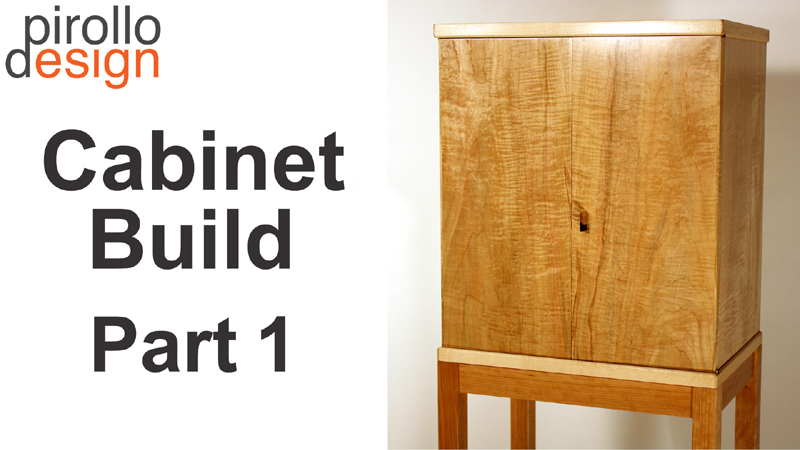
The following topics are covered in detail in this 16 part design and build class:
- Inspiration and design of the display cabinet
- An overview discussing components of the cabinet
- Wood selection and resawing veneers used in cabinet
- The advantages of using veneers over solid wood
- Detailed information on creating and using resawn veneers
- The process of applying veneers to the sides and doors
- Implementing bake-ins to create panels with hardwood edges
- Hardwood edging and the veneer press
- The veneer press and joinery used in the cabinet
- Card scrapers and the use of a shop-made drilling guide
- Dowel drilling guide in-depth
- The case construction process
- Frame and panel construction of the back panel
- Back panel detail and installation
- Final case assembly of the display cabinet
- Installation process of knife hinges for the doors
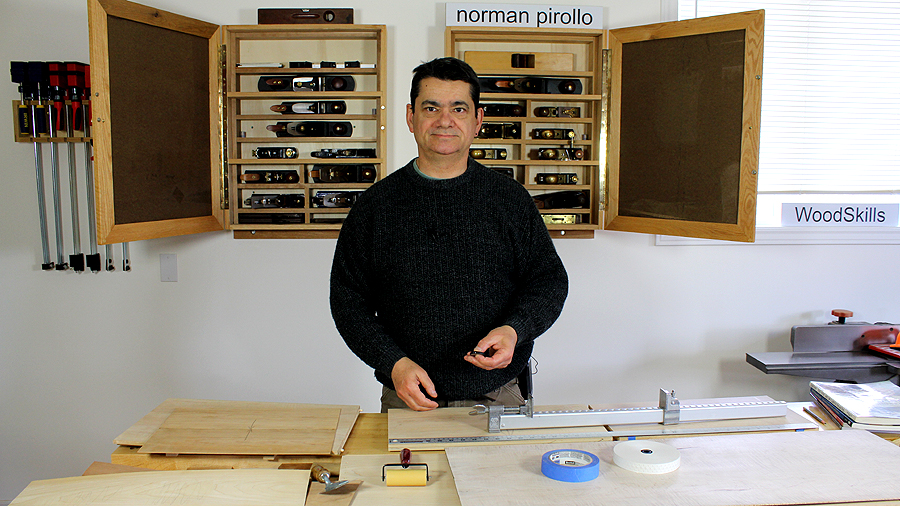
Wednesday, October 11, 2017
Furniture Design Course
In this new course, I cover the furniture design topic. This is a topic near and dear to me as I believe that good design is essential in a quality furniture piece. Good design also minimizes wasted resources and provides a furniture maker with essential feedback and pause when creating furniture. Loosely translated, the design process keeps the maker from rushing into a potentially flawed furniture design. The checks and balances give pause to the process as well as streamlining the build. Developing your own style and furniture aesthetic is also covered. Selecting the right woods for your furniture design is critical in determining the appeal of the final furniture piece.
As with most woodworkers, I was anxious to build furniture early on. With the passage of time and several furniture projects completed, the anxiety of simply creating work had passed. It was far more important to create a well-designed and striking piece of furniture. So I delved into furniture design, studied with some renown furniture makers, and used this knowledge to establish a furniture design process that works.
In the online furniture design course you will learn the skills necessary to design and create your own unique furniture. Learn to develop your own style of furniture and aesthetic. Over 2 hours in total. Course features videos on these topics:
As with most woodworkers, I was anxious to build furniture early on. With the passage of time and several furniture projects completed, the anxiety of simply creating work had passed. It was far more important to create a well-designed and striking piece of furniture. So I delved into furniture design, studied with some renown furniture makers, and used this knowledge to establish a furniture design process that works.
In the online furniture design course you will learn the skills necessary to design and create your own unique furniture. Learn to develop your own style of furniture and aesthetic. Over 2 hours in total. Course features videos on these topics:
- Furniture design overview, the history of furniture design
- Becoming familiar with the furniture design process
- Understand design process, bring your furniture designs to next level
- How to select wood for a furniture design
- Use of mockups and prototypes to develop a furniture design
- In-depth use of mockups to develop a furniture design
- Determining a furniture style for your own furniture designs
- Selecting a furniture style and aesthetic
- Developing a furniture design
- Getting the proportions right in a furniture design
- Using the dynamic design process in a furniture design
- Use of maquettes and prototypes in a furniture design
- Use of templates and CAD when designing your furniture
More information at: Furniture Design Course
Monday, September 18, 2017
The Wood Artist: Creating Art Through Wood
I've been working at writing a book on and off these past few months. Only in the last two weeks has the final title been decided on: The Wood Artist: Creating Art Through Wood. The book chronicles the evolution of my wood art and sculpture over several years. Several discoveries about wood are noted. I am excited about this book as this particular subject is part of the continuum of my second career as a furniture maker and wood artist. A few years ago, I never would have envisioned being part of the art world. It is through the medium of wood that I stumbled into it. One thing led to another and soon I developed a sufficient body of work to make serious inroads into the art world. Shifting from creating functional furniture to creating purely non-functional, non-objective art was challenging at times. At the same time, the creation of art unleashed a newfound creativity and vision that could not be manifested through my furniture designs.
This is more than simply a picture book. In it I discuss the methodology and processes I developed to be able to create small and large pieces of wood art. As well, discoveries about the inherent characteristics and beauty of wood are discussed. Both sculptural and wall art are part of the journey. The wood art and sculpture closely follow the genre of contemporary art. It has been an exciting period in my career as both a woodworker and wood artist. I continue to work at both today. The book is 215 pgs. in total. So I created this video as a retrospective of some of my recent work. The evolution includes the introduction of curved elements and colored wood at different points. Currently it is in the final stage of completion. The final version is being proof-read at this time. The book is targeted for publication October 12, 2017. Information on ordering will be at: www.refinededge.com/books
This is more than simply a picture book. In it I discuss the methodology and processes I developed to be able to create small and large pieces of wood art. As well, discoveries about the inherent characteristics and beauty of wood are discussed. Both sculptural and wall art are part of the journey. The wood art and sculpture closely follow the genre of contemporary art. It has been an exciting period in my career as both a woodworker and wood artist. I continue to work at both today. The book is 215 pgs. in total. So I created this video as a retrospective of some of my recent work. The evolution includes the introduction of curved elements and colored wood at different points. Currently it is in the final stage of completion. The final version is being proof-read at this time. The book is targeted for publication October 12, 2017. Information on ordering will be at: www.refinededge.com/books
Labels:
contemporary art,
sculpture,
wall art,
wood art,
woodworking
Friday, August 18, 2017
1860's Sawmill & Cabinetmaker shop
This past week while camping I toured an authentic 1860's pioneer village in the area. We camp in the same area each year and try to visit Upper Canada Village while there. With each visit I learn something new or pick out a detail I missed on previous visits. One favorite stop is the authentic sawmill which continues to produce boards to this day. Most of the wood is used within the village. Watching the water-powered bandsaw in operation continues to amaze me. The innovative features built-in to process logs into boards are nothing short of ingenious. There is also a system to use trucks on wheels to transport logs in , then roll them onto the bandsaw platform for ripping. The videos below shows the bandsaw in operation and water turbine at the lower level. Blade is stationary except for up and down movement. The log is advanced into the blade through a system of geared steel wheels and detents. The bandsaw is powered by a shaft driven by a turbine wheel. The water is piped in to the sawmill through a system of square wood pipes which increase the velocity of water to spin the turbine. Water begins at one height when entering the sawmill and exits at a lower level. This is what causes the water to increase in velocity. The bandsaw mill works well with old growth white pine brought in from another area.
Video here: Water-Turbine
Video here: Water-powered 1860 bandsaw
Another favorite stop is the authentic cabinetmaker shop where furniture is continually churned out, albeit at a much slower pace we are familiar with. Most of the furniture produced in the shop is used in the authentic pioneers village. All furniture is created with hand tools as relatively no woodworking machines existed in this era. The Industrial Age was just beginning. Watching the cabinetmaker (David Jones) and apprentice provided a real appreciation for a slower, manual form of woodworking.
So I had the opportunity to do a short film of David Jones (resident master cabinetmaker) and apprentice. I asked a few questions while filming. They are currently working on a side table with frame and panel doors and drawers. All joinery is either pinned mortise and tenon or dovetails.
I have probably visited this Cabinetmakers shop four times to date and continue to enjoy discussing with the resident cabinetmakers their work methods and current projects.
Video here: 1860 Cabinetmaker Shop
I then visited the blacksmith shop which also doubles as the ferrier shop for the horses in the village. Had a good talk with the blacksmith. At the time he was forging a keyway for a geared wheel in a piece of machinery used in the crop fields of the village.
Video here: Water-Turbine
Video here: Water-powered 1860 bandsaw
Another favorite stop is the authentic cabinetmaker shop where furniture is continually churned out, albeit at a much slower pace we are familiar with. Most of the furniture produced in the shop is used in the authentic pioneers village. All furniture is created with hand tools as relatively no woodworking machines existed in this era. The Industrial Age was just beginning. Watching the cabinetmaker (David Jones) and apprentice provided a real appreciation for a slower, manual form of woodworking.
So I had the opportunity to do a short film of David Jones (resident master cabinetmaker) and apprentice. I asked a few questions while filming. They are currently working on a side table with frame and panel doors and drawers. All joinery is either pinned mortise and tenon or dovetails.
I have probably visited this Cabinetmakers shop four times to date and continue to enjoy discussing with the resident cabinetmakers their work methods and current projects.
Video here: 1860 Cabinetmaker Shop
I then visited the blacksmith shop which also doubles as the ferrier shop for the horses in the village. Had a good talk with the blacksmith. At the time he was forging a keyway for a geared wheel in a piece of machinery used in the crop fields of the village.
Labels:
bandsaw,
cabinetmaker,
cabinetmaking,
furniture making,
ripping logs,
sawmill,
sawyer,
woodworking
Tuesday, July 25, 2017
Bench stops (12th anniversary)...
In 2005, I developed this system of bench stops as a simple alternative to installing a tail vise on a workbench. So I've been using this system of bench stops for 12 years now, it will be the 12th anniversary shortly! The system is set up on one of my original workbenches which happened to be my main workbench at the time. This particular shop-made workbench did not lend itself well to incorporating a tail vise so I told myself there had to be a better way to hold boards firmly while hand planing. Apologies for the vintage photography, but I wanted to keep the article period correct :)
This alternative tail-vise setup is used when face planing boards. Most flat, regular benches can easily be modified to incorporate this hand planing setup using bench stops ( Roubo style). Photos below are of the bench stop setup on the workbench in my workshop. This bench has been modified for adapting the two bench stops. Adapting a bench can be expanded for longer bench stops, more holes for versatility, etc. I chose this particular hole spacing for the type of work I do. I am also left-handed and plane left to right, therefore I set this up on the back side of my bench which is unencumbered by a face vise ( the face vise at front of bench ).
It is critical to get the 3/4 in. dowel holes square to the bench and in-line with each other, to ensure that the 12 in. bench stops are perpendicular to each other. The side bench stop does a great job of preventing the board from rotating sideways while hand planing with diagonal strokes. It has a large bearing surface to keep any size board from rotating. The side bench stop is also movable within a 12 in. span on 3 sets of holes, allowing for narrow boards and wider boards (2 in. to 14 in.).

The side bench stop can be swung around towards the front bench stop with a parallel set of holes, this is to accommodate shorter boards. Pictures above and below provide a better explanation.
The wide front bench stop also serves to prevent the board from rotating or shifting sideways as it has a large bearing surface for the front edge of the board. Bench stops (front and side) are friction fit so they can be raised (1/4 in. to 3/4 in.) to accommodate thicker boards, very much like a bench dog. Otherwise, the minimum height of the bench stops would be approximately 1/4 inch. The hole spacing is arbitrary and based on the type of board sizes I typically hand plane in my own furniture making. two inch long birch dowels are glued in the bench stops using ebony wedges. The wedges are inserted into kerfs created in the ends of the dowels for tightness. Kerfs at the ends of the dowels are cut on a bandsaw.
A benefit of having a board simply against bench stops is that you really cannot drag the plane back in your strokes since it would pull the board back. This trains you to lift the handplane instead of dragging it back. The only wear on the blade then is from the forward stroke. Also you eliminate the tendency of bowing a thinner board caused by clamping between bench dogs and tail-vise and distorting the board while planing. You also gain more tactile feedback and control of your planing and it becomes easy and quick to re-orientate the board end for end or flip it over, etc.

Typical bench stop setup to act as a tail vise.

More holes can be added to allow for very short boards as done in bottom pictures. It is then a matter of swinging the side bench stop around towards the front bench stop. The spacing and location I have selected is optimized for the length and width of boards I typically handplane in my furniture making.

The bored 3/4 in. holes can also be used for bench dogs and holdfasts for irregular sized pieces.

Align side bench stop to be perpendicular with face of front bench stop using a large square to mark holes. This will ensure the complete edge of the bench stop is against the board to be planed.

Side bench stop set to narrowest width, closest to edge of bench.

Bench stops can be raised or lowered as conventional bench stops for thinner or thicker boards.

A short, narrow piece of lacewood being planed.

Parallel set of holes bored to accommodate shorter and wider boards shown above. It is recommended to lay out all the holes you will need for this system and then drill them. This method ensures that all holes are square and perpendicular to each other and the front bench stop.

A small, wide panel being face-planed.
Developing this alternative tail vise idea led to an article on bench stops and jigs I wrote for Fine Woodworking Magazine. The 4 Bench Jigs for Handplanes article was published in early 2009.
This alternative tail-vise setup is used when face planing boards. Most flat, regular benches can easily be modified to incorporate this hand planing setup using bench stops ( Roubo style). Photos below are of the bench stop setup on the workbench in my workshop. This bench has been modified for adapting the two bench stops. Adapting a bench can be expanded for longer bench stops, more holes for versatility, etc. I chose this particular hole spacing for the type of work I do. I am also left-handed and plane left to right, therefore I set this up on the back side of my bench which is unencumbered by a face vise ( the face vise at front of bench ).
It is critical to get the 3/4 in. dowel holes square to the bench and in-line with each other, to ensure that the 12 in. bench stops are perpendicular to each other. The side bench stop does a great job of preventing the board from rotating sideways while hand planing with diagonal strokes. It has a large bearing surface to keep any size board from rotating. The side bench stop is also movable within a 12 in. span on 3 sets of holes, allowing for narrow boards and wider boards (2 in. to 14 in.).
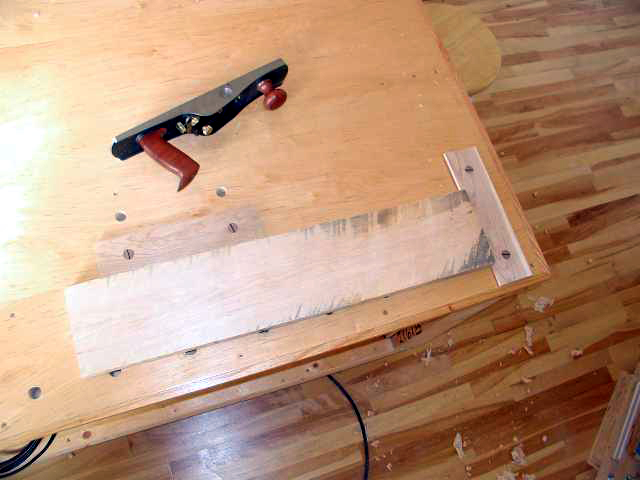
The side bench stop can be swung around towards the front bench stop with a parallel set of holes, this is to accommodate shorter boards. Pictures above and below provide a better explanation.
The wide front bench stop also serves to prevent the board from rotating or shifting sideways as it has a large bearing surface for the front edge of the board. Bench stops (front and side) are friction fit so they can be raised (1/4 in. to 3/4 in.) to accommodate thicker boards, very much like a bench dog. Otherwise, the minimum height of the bench stops would be approximately 1/4 inch. The hole spacing is arbitrary and based on the type of board sizes I typically hand plane in my own furniture making. two inch long birch dowels are glued in the bench stops using ebony wedges. The wedges are inserted into kerfs created in the ends of the dowels for tightness. Kerfs at the ends of the dowels are cut on a bandsaw.
A benefit of having a board simply against bench stops is that you really cannot drag the plane back in your strokes since it would pull the board back. This trains you to lift the handplane instead of dragging it back. The only wear on the blade then is from the forward stroke. Also you eliminate the tendency of bowing a thinner board caused by clamping between bench dogs and tail-vise and distorting the board while planing. You also gain more tactile feedback and control of your planing and it becomes easy and quick to re-orientate the board end for end or flip it over, etc.

Typical bench stop setup to act as a tail vise.
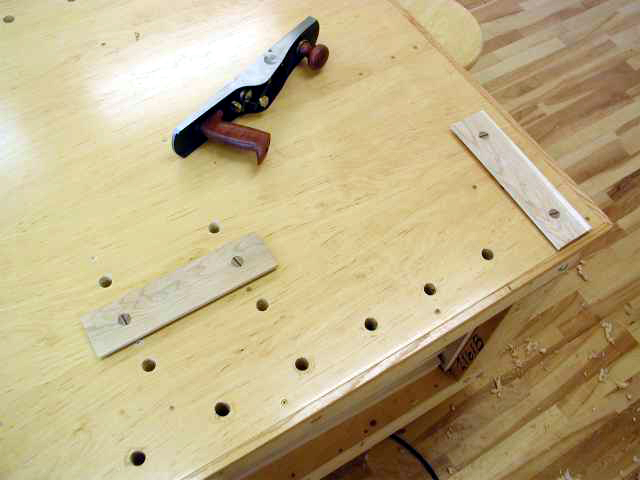
More holes can be added to allow for very short boards as done in bottom pictures. It is then a matter of swinging the side bench stop around towards the front bench stop. The spacing and location I have selected is optimized for the length and width of boards I typically handplane in my furniture making.
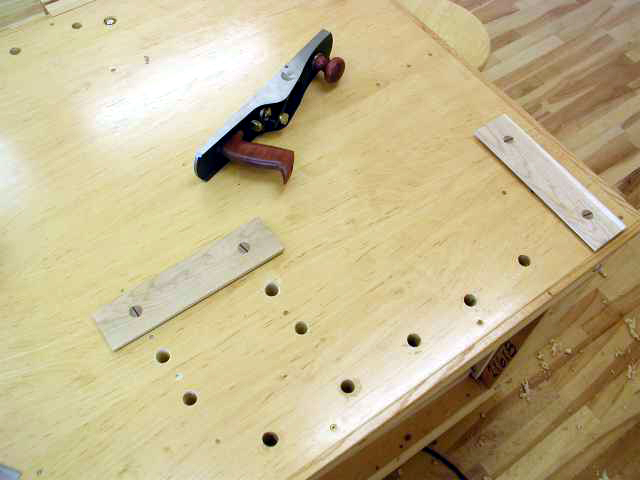
The bored 3/4 in. holes can also be used for bench dogs and holdfasts for irregular sized pieces.
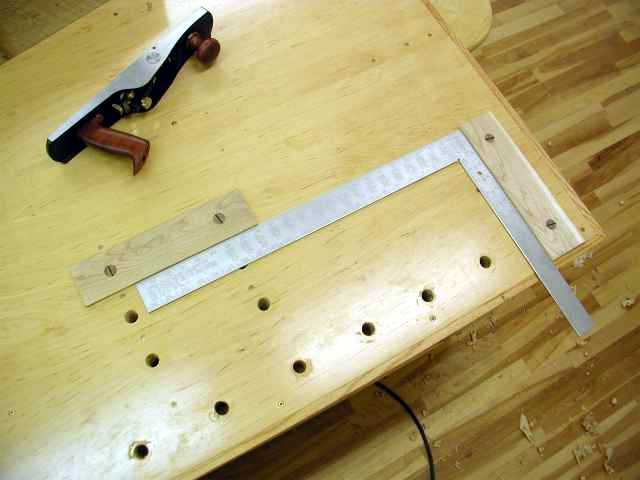
Align side bench stop to be perpendicular with face of front bench stop using a large square to mark holes. This will ensure the complete edge of the bench stop is against the board to be planed.
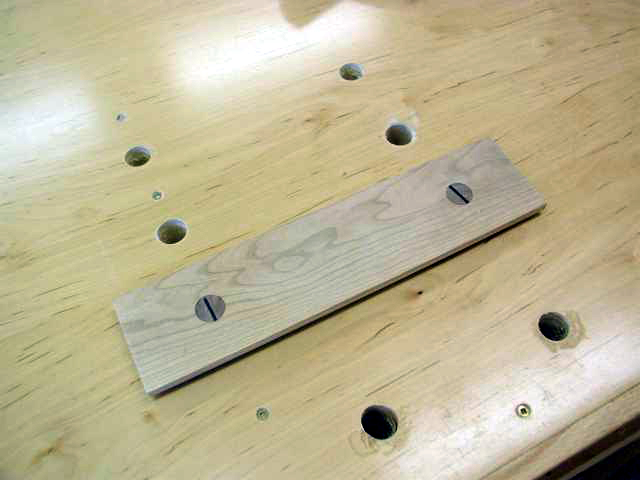
Side bench stop set to narrowest width, closest to edge of bench.
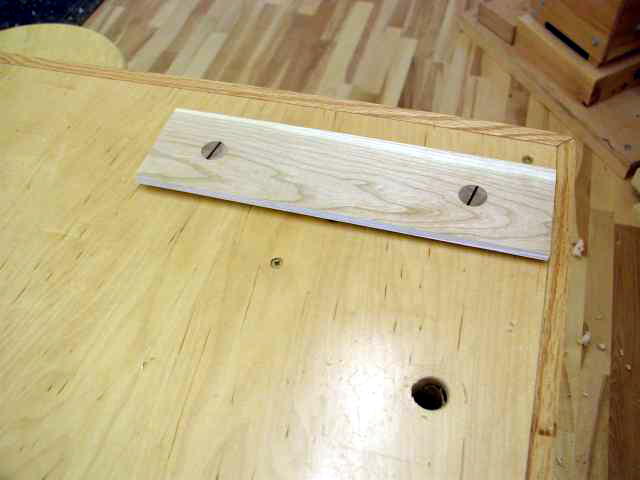
Bench stops can be raised or lowered as conventional bench stops for thinner or thicker boards.
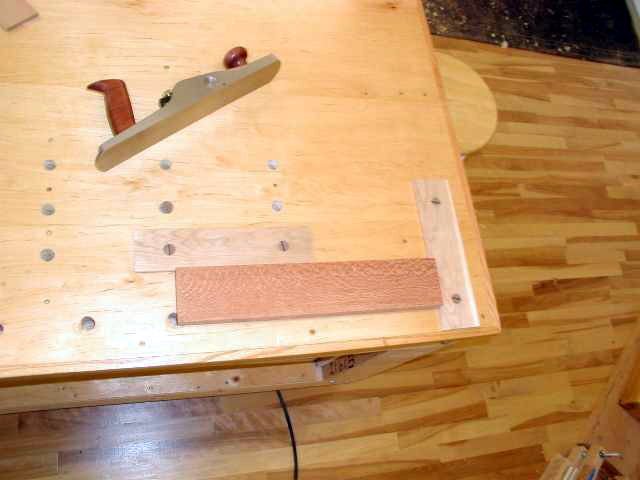
A short, narrow piece of lacewood being planed.
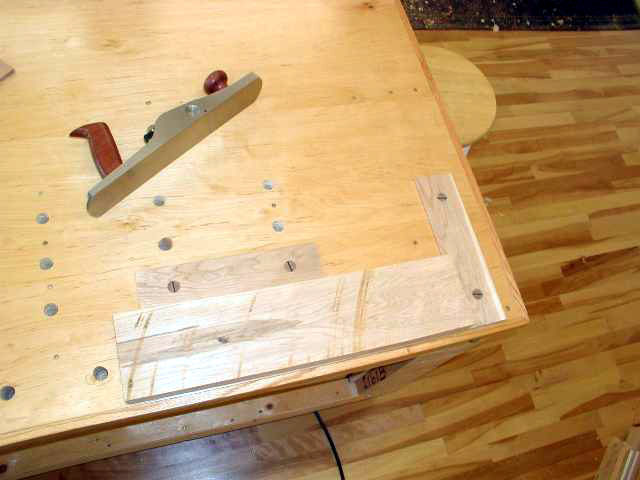
Parallel set of holes bored to accommodate shorter and wider boards shown above. It is recommended to lay out all the holes you will need for this system and then drill them. This method ensures that all holes are square and perpendicular to each other and the front bench stop.
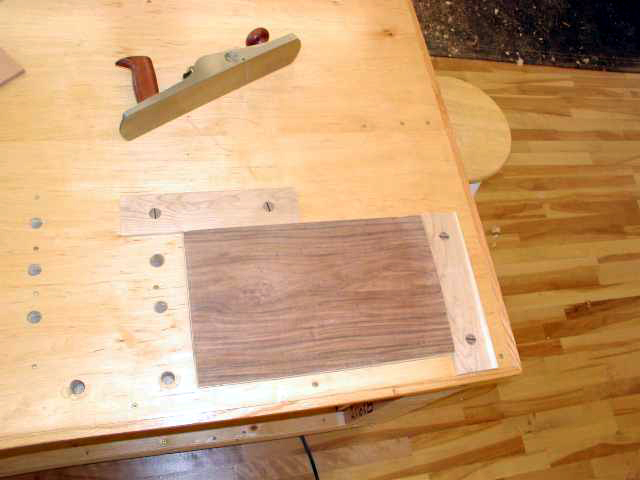
A small, wide panel being face-planed.
Developing this alternative tail vise idea led to an article on bench stops and jigs I wrote for Fine Woodworking Magazine. The 4 Bench Jigs for Handplanes article was published in early 2009.
Sunday, July 23, 2017
Furniture maker's mark
The concept of a maker’s mark is not a new one. It has been around for centuries. It is a means to distinguish one’s work from another maker. It also adds a personal touch to every piece created by a maker. I have incorporated maker’s marks in my own work for the past two decades and have had excellent feedback from clients. Clients love the fact that the furniture piece they purchase is created by an individual. It adds to the cachet of the piece and serves to provide identification of the origin of the piece. Decades from now, the maker’s mark instantly identifies the furniture piece as created by a particular maker with the location of its creation. The new maker’s mark designed for my studio captures the essence of my work and the detail I like to instill in my work.
So I also use the new maker’s mark for my other work, namely woodworking tools. I find a place on each tool to inlay the maker’s mark. In a strange way, adding a maker’s mark inspires me to do my best work. Attaching my name to a furniture piece or handmade tool makes me more conscious of how the tool or furniture will likely be passed on from generation to generation.
I hope everyone is enjoying the summer. It is my favourite time of year. I can shed the layers of clothing worn in other seasons and simply walk out the door. No complaints here about heat or humidity. The hot, humid part only really lasts a few weeks or months and the freezing cold alternative is always fresh on my mind 🙂 More tools at: www.refinededge.com
Wednesday, June 28, 2017
Miter saw stand...
A while ago, I realized that my workflow would be more efficient if I had the means to cut long planks into manageable pieces. Longer planks ensure that wood graphics are consistent in the woods used in a particular furniture piece. The pieces would be, in turn, processed on a jointer and thickness planer. In the case of highly figured tearout-prone woods, I would use a series of hand planes to achieve the desired board thickness.
Until this time, I would crosscut large planks using a hand-held circular saw. If any precision was necessary at all, the circular saw left something to be desired. So enter the miter saw. I purchased a sliding miter saw and designed and built a stand for it. The criteria for the stand were that it be portable so I could move it around the shop if necessary. It was also important that it be designed to be folded up after use and placed along a wall. The intention was to have the miter saw available occasionally for cutting large planks down to size. I only ever work with one or two planks for a particular piece of furniture, so the miter saw could be put away between use. A few of the wide boards I use in my furniture can be seen against the wall at the left.
I designed and built this miter stand for my particular miter saw, a Dewalt 10 in. model. The miter saw itself can easily be detached from the stand and the table surface folded onto the metal sawhorses below. Since this would be a custom build, I could make the miter stand as long as I like. I decided on a length of over 7 feet. The left and right tables each have a fence system aligned with the miter saw fence. The largest width of planks I could process is approximately 10 inches. This is as wide as most, if not all of the planks I ever use in my work. Anything wider I can either rip an edge off or find alternative means to cross-cut it.
Each fence has its own track system with both shop-made wood stops and retail metal stops. I uses the torsion box principle to build the left and right tables. Even with the utmost design in mind, it was necessary to make changes. When wide miter cuts were necessary on large wood pieces, it would be convenient to use the miter saw. This hold more true if the cuts are repeatable as when working with multiples. Swinging the saw completely to the left or right was an issue. Hence the re-designed mitered corners in both the left and right tables. I can set the saw to extreme miter angles now, greater than I would normally use in my work. So after replacing the corner of either table with hardwood cherry blocks and trimming, the mitered corners can be seen below.
I have been using this miter saw and stand setup for a long while now. I never did fold and put it away. It is so convenient that I prefer it to remain set up. Soon after using it for the first few times, I realized dust control would be necessary. A dust port adapter was set up to connect the sawdust exhaust port to a dedicated shop vacuum. Still debating whether I need to make a dust shroud for it, but it works well as is and I like that it isn't hidden in a shroud. Overall, a fun, exciting build and at times challenging!
Until this time, I would crosscut large planks using a hand-held circular saw. If any precision was necessary at all, the circular saw left something to be desired. So enter the miter saw. I purchased a sliding miter saw and designed and built a stand for it. The criteria for the stand were that it be portable so I could move it around the shop if necessary. It was also important that it be designed to be folded up after use and placed along a wall. The intention was to have the miter saw available occasionally for cutting large planks down to size. I only ever work with one or two planks for a particular piece of furniture, so the miter saw could be put away between use. A few of the wide boards I use in my furniture can be seen against the wall at the left.
I designed and built this miter stand for my particular miter saw, a Dewalt 10 in. model. The miter saw itself can easily be detached from the stand and the table surface folded onto the metal sawhorses below. Since this would be a custom build, I could make the miter stand as long as I like. I decided on a length of over 7 feet. The left and right tables each have a fence system aligned with the miter saw fence. The largest width of planks I could process is approximately 10 inches. This is as wide as most, if not all of the planks I ever use in my work. Anything wider I can either rip an edge off or find alternative means to cross-cut it.
Each fence has its own track system with both shop-made wood stops and retail metal stops. I uses the torsion box principle to build the left and right tables. Even with the utmost design in mind, it was necessary to make changes. When wide miter cuts were necessary on large wood pieces, it would be convenient to use the miter saw. This hold more true if the cuts are repeatable as when working with multiples. Swinging the saw completely to the left or right was an issue. Hence the re-designed mitered corners in both the left and right tables. I can set the saw to extreme miter angles now, greater than I would normally use in my work. So after replacing the corner of either table with hardwood cherry blocks and trimming, the mitered corners can be seen below.
I have been using this miter saw and stand setup for a long while now. I never did fold and put it away. It is so convenient that I prefer it to remain set up. Soon after using it for the first few times, I realized dust control would be necessary. A dust port adapter was set up to connect the sawdust exhaust port to a dedicated shop vacuum. Still debating whether I need to make a dust shroud for it, but it works well as is and I like that it isn't hidden in a shroud. Overall, a fun, exciting build and at times challenging!
Monday, May 29, 2017
Horizontal slot mortiser (update)...
So I just created a 2-part video of the Jessem Mortise Mill mounted on my rolling cart. The two-part video for this can be seen at: https://www.youtube.com/WoodskillsCourses . Tech in wood joinery meets handcrafted design + build. Top is the mortising unit mounted horizontally, below the micro-adjust system. The original story follows as this is an update to an earlier post. The Jessem Mortise Mill unit was purchased a few years back and I created a few loose tenon slots successfully with it. The original mortiser design was to mount it vertically and use a power drill from the top down. Although this worked, I found the drill pressure would push the board down no matter how much clamping pressure I used. So I put the Mortise Mill aside for a few years until recently. During a shop reorg, I found the unit gathering dust and decided to re-incorporate it in my shop. I had always wanted a horizontal slot mortise and thought why not set this up to create slots horizontally instead of vertically. Original instructions were to install it vertically with boards placement underneath. So I decided instead to mount it so slots were created horizontally as a horizontal slot mortiser.
Next step was to find a suitable platform, i.e. workbench surface to mount it. A rolling cart in my workshop was ideal since I could wheel the unit away when not in use and the footprint of the Mortise Mill was not large. The rolling cart has large locking casters which do a good job of keeping the cart immobile. Installed it so the surface of the base plate was even with the surface of the cart, this took some time. I used large enough 1/4-20 bolts to maintain rigidity and keep it from shifting. The Jessem mortise Mill requires that a shop-vac be attached to the dust port otherwise the unit begins to clog up with sawdust, this can also be seen in the videos.
Have been using it since and am pleased with the system. The addition of the L-shaped wood bracket to support stiles while being mortised works well. The ends of rails to be mortised are easily supported by the wood surface of the rolling cart. I like the fact that I can permanently leave the Mortise Mill bolted to the rolling cart.
The only small issue was the vertical adjustment of the slots on a board. Since the Mortise Mill was installed horizontally, the adjustment was not as smooth as I would like due to the weight of the sliding carriage of the unit. Notice the etchings on the Mill are upside down. So, using scrap walnut and maple, in comes the micro-adjust setup to solve the problem. It is all wood construction with a 1/2 inch lead screw and wood handle. The end of the lead screw has a custom cradle contoured to fit the bottom edge of the sliding part of the Mortise Mill. I can precisely dial-in slot placements for either offset or different thickness boards now!
Since the micro-adjust system is cantilevered off the rolling cart, I beefed up the supports, it's probably over-engineered now. Things to watch are the exact placement of the tip of the lead screw over the center of the edge of the Mortise Mill for smooth operation. A large paddle switch for the built-in Mortise Mill dust collection was installed for convenient access.
Completed, tested and have been using for a few months now. Works great!
Monday, May 1, 2017
Cabinet build...
I’ve been working on the components for a standalone cabinet lately. As well, working on the design of a second smaller cabinet with a unique focal point, to be discussed later. The cabinet on stand below features one of my favorite figured woods, domestic ambrosia maple. I have a small stash of this wood in planks so the decision was made to resaw the wide planks and create veneers. Veneers maximize the yield from the planks. The cabinet will have veneered front doors and side panels. The remainder of the cabinet, the top and bottom panels and back panel consist of conventional maple. Ambrosia maple, when finish is applied, exhibits a beautiful, warm color while accentuating the wild graphics it is renown for. The graphics are what draw me to ambrosia maple. Also, it is a member of the soft maple family, so not difficult to work with and to smooth the surfaces. One of the attached pics is an earlier cabinet I completed using ambrosia maple throughout.
I have yet to decide on the finish of the current cabinet build, definitely something that will highlight the wood graphics.The other pics are the almost completed panels I will be using in the build. The veneered panels are not exciting at this time, but application of a penetrating clear finish will pop the graphics, colors and grain. The frame and panel back is a work in progress at this time. The interior compartments will also be different but consist of dovetailed drawers in an unusual arrangement.
The dimensions in the current version will be close to that of the earlier version since the proportions appealed to me. I have not yet designed or created the components for the stand, so this might be different than the earlier version. What I typically do is build the cabinet, then begin work on the platform or stand. The process is not as overwhelming to me using this approach, as I prefer to work on a project in stages. The satisfaction of seeing tangible progress in the project motivates and excites me to continue :) More details to follow on the individual components and joinery used.
I have yet to decide on the finish of the current cabinet build, definitely something that will highlight the wood graphics.The other pics are the almost completed panels I will be using in the build. The veneered panels are not exciting at this time, but application of a penetrating clear finish will pop the graphics, colors and grain. The frame and panel back is a work in progress at this time. The interior compartments will also be different but consist of dovetailed drawers in an unusual arrangement.
The dimensions in the current version will be close to that of the earlier version since the proportions appealed to me. I have not yet designed or created the components for the stand, so this might be different than the earlier version. What I typically do is build the cabinet, then begin work on the platform or stand. The process is not as overwhelming to me using this approach, as I prefer to work on a project in stages. The satisfaction of seeing tangible progress in the project motivates and excites me to continue :) More details to follow on the individual components and joinery used.
Tuesday, March 7, 2017
Table Saw build...
Someone might ask, why would you build your own table saw? I agree, there are so many inexpensive ones to choose from out there. Why re-invent the wheel? Well, there is some logic to my madness. This table saw is a work in progress and will have features not available in current table saws. So without going into any more detail, here is a glimpse of what I have so far. It is a scaled-down version of a bench saw, has an adjustable fence and sports a 7 in. thin-kerf blade. I'm actually enjoying this build and the research necessary to make my idea work. I won't be discussing the drive motor and any of the features until a later date.
There is more work to be done but at the moment it does function as a mini table saw.
https://www.youtube.com/WoodskillsCourses
There is more work to be done but at the moment it does function as a mini table saw.
https://www.youtube.com/WoodskillsCourses
Tuesday, February 28, 2017
"Rooted" book has arrived...
A few months ago I was notified that my entry had been selected for an upcoming book on contemporary furniture. I finally managed to get hold of the book and received it this week.
The Schiffer publication: Rooted: Creating a Sense of Place: Contemporary Studio Furniture features a selection of contemporary furniture typically created in furniture studios by a single maker.
Quote from Amazon.com: "The movement to buy locally, which has gained momentum in the areas of produce and food, is now spreading to arts and crafts. Through the work of over seventy contemporary furniture makers, the role of place in the creative process is explored and celebrated. Whether in terms of materials, inspiration, or the interaction with customers, these artists are rooted in their surroundings. What springs from these roots is usually unique, often edgy, and always beautiful furniture and accessories."
In a few days, I will post the first part of a series of videos on Furniture Design at my WoodSkills YouTube channel. Working on this as we speak. It began as a small exercise but I'm adding material and more of my knowledge on this topic.
The Schiffer publication: Rooted: Creating a Sense of Place: Contemporary Studio Furniture features a selection of contemporary furniture typically created in furniture studios by a single maker.
Quote from Amazon.com: "The movement to buy locally, which has gained momentum in the areas of produce and food, is now spreading to arts and crafts. Through the work of over seventy contemporary furniture makers, the role of place in the creative process is explored and celebrated. Whether in terms of materials, inspiration, or the interaction with customers, these artists are rooted in their surroundings. What springs from these roots is usually unique, often edgy, and always beautiful furniture and accessories."
In a few days, I will post the first part of a series of videos on Furniture Design at my WoodSkills YouTube channel. Working on this as we speak. It began as a small exercise but I'm adding material and more of my knowledge on this topic.
Saturday, January 28, 2017
Clearing the air...
With the experience of my first workshop in mind, dust control became a priority for me when designing my new workshop. I recall not only sweeping the floors in my previous shop but also sweeping the walls of dust. The dust was the flavour of the day, be it walnut, padauk, cherry, mahogany. The dark, exotic woods were the worst for dust. I installed some dust collection but it was never enough. At the time, my woodworking was more oriented towards the use of sanding in the final stages of a build, so this didn't help. The dust collection I installed was to capture the dust at the source or as it was being generated. This worked to a degree but there would always be airborne dust floating around, a by-product of whatever wood processing I was performing at the time. This is the dust that collects on walls, stays in the air and is unfortunately breathed in.
To combat this I built a 3-stage air cleaner as there were next to no commercial units available at the time or they were expensive. This helped considerably in capturing the airborne dust and I immediately became a believer in effective dust control. The shop made air cleaner can be seen here as well as a 3-stage commercial unit just above it. The shop made air cleaner is now moved into my new workshop and together these units effectively clean and circulate the air. Both units are stack-mounted in an unused part of the shop above a stairwell. The air in the shop is recirculated from top to bottom many times per hour and in the process scrubbing the air of fine particulate dust. I use these air cleaners in conjunction with two large capacity DC systems with blast gates at each of the stationary machines in the workshop. So dust control is an important part of my woodworking now. My woodworking today also places much less emphasis on sanding and instead I use hand tools to smooth surfaces of wood.
The air cleaners are turned on using a hand-held remote control. The most recent addition is the large red neon pilot lamp which indicates that the air cleaners are running. When I am using a machine, it is difficult to tell if the air cleaners have been turned on since the machine noise exceeds that of the air cleaners. The newly-installed red pilot lamp is immediately noticeable. The air cleaners also have ducting at the rear to direct air downwards to create the recirculating pattern for the shop air.
To combat this I built a 3-stage air cleaner as there were next to no commercial units available at the time or they were expensive. This helped considerably in capturing the airborne dust and I immediately became a believer in effective dust control. The shop made air cleaner can be seen here as well as a 3-stage commercial unit just above it. The shop made air cleaner is now moved into my new workshop and together these units effectively clean and circulate the air. Both units are stack-mounted in an unused part of the shop above a stairwell. The air in the shop is recirculated from top to bottom many times per hour and in the process scrubbing the air of fine particulate dust. I use these air cleaners in conjunction with two large capacity DC systems with blast gates at each of the stationary machines in the workshop. So dust control is an important part of my woodworking now. My woodworking today also places much less emphasis on sanding and instead I use hand tools to smooth surfaces of wood.
The air cleaners are turned on using a hand-held remote control. The most recent addition is the large red neon pilot lamp which indicates that the air cleaners are running. When I am using a machine, it is difficult to tell if the air cleaners have been turned on since the machine noise exceeds that of the air cleaners. The newly-installed red pilot lamp is immediately noticeable. The air cleaners also have ducting at the rear to direct air downwards to create the recirculating pattern for the shop air.
Wednesday, January 25, 2017
Wood offcuts (save or burn)...
Not the most exciting blog post but I finally got around to cleaning out the piles and piles of offcuts I had been storing throughout my workshop. What brought this about is I literally had run out of space, piles were brimming with wood offcuts of every size. It gets to a point where it doesn’t make sense to keep collecting the wood, I’ll only generate more anyway! So how to go about this task since the most difficult thing is parting with an offcut that might be of use in a future project as this is instilled in us as woodworkers. As we all know, hardwoods have become expensive so the offcuts become more precious as time goes on. After all, they have already been processed, planed, squared, etc. Pics reflect the post-tidying, uncluttered look.
I began by tackling two large grey bins that were literally overflowing. I could not place one more scrap piece in them. The laborious task of sifting through them began. It was much like an archaeological dig of past projects. Each layer reminded me of an earlier project and once I got to the bottom I could see some of my earlier work. I moved the larger pieces to two large cardboard boxes to be stored away in a completely different part of the building. The remainder I intend to use as fireplace kindling. Once I got through the first grey bin, the second one was easy. I conditioned myself to be discriminating and if I thought the offcut was not worth saving, it would become kindling. It has been at least 3 years since these bins have been completely emptied.
Next were 3 other wood piles that had grown to an unwieldy size. One pile in particular beneath my vacuum pump had become an eyesore. This had to get sorted out. I recently purchased a new shop vac and the box it came in was a large enough size for these longer offcuts. Next issue was where to place the box. If I kept it in plain view I would have accomplished nothing except move wood offcuts from one pile to another. I needed to find an unused space, preferably out of sight. The space behind a dust collector was not used and just the right size. The large box of offcuts was also placed on a small dolly with casters I had lying around. Now I can conveniently access these longer offcuts and if necessary easily move the box to a different location.
With this all done, I tackled the shelves under two of my larger workbenches below. It is so true what they say that these shelves eventually become storage for anything and everything. By now I was merciless, I wanted clean surfaces free of clutter. This exercise also provided me the opportunity to get re-acquainted with some buried tools and hardware.
The last task was to clean the tops of the two smaller, identical workbenches below. In one case, the workbench top had not been cleaned in maybe 3 years. Everything was removed from each of the two workbench tops and put back in its place, be it drawers or cabinets. From now on I will work hard at leaving workbench surfaces free of clutter and deal with offcuts as I work through a project. After all, I have enough offcuts already to last a lifetime. Will I ever use them all, probably not. Maybe donate them to woodworkers that create smaller objects?
Last but not least is a large beast of a workbench (seen below) I made years ago. I had moved this workbench to an area of the lower level workshop and it has slowly become a storage area with occasional use as a workbench. I need to tackle this area next and cull some of the wood, tools and hardware accumulated over the years. I have always enjoyed using this workbench and want to make it available once again. So I will be cleaning and tidying up this area up tomorrow with the intent to have a usable workbench once again.
I began by tackling two large grey bins that were literally overflowing. I could not place one more scrap piece in them. The laborious task of sifting through them began. It was much like an archaeological dig of past projects. Each layer reminded me of an earlier project and once I got to the bottom I could see some of my earlier work. I moved the larger pieces to two large cardboard boxes to be stored away in a completely different part of the building. The remainder I intend to use as fireplace kindling. Once I got through the first grey bin, the second one was easy. I conditioned myself to be discriminating and if I thought the offcut was not worth saving, it would become kindling. It has been at least 3 years since these bins have been completely emptied.
Next were 3 other wood piles that had grown to an unwieldy size. One pile in particular beneath my vacuum pump had become an eyesore. This had to get sorted out. I recently purchased a new shop vac and the box it came in was a large enough size for these longer offcuts. Next issue was where to place the box. If I kept it in plain view I would have accomplished nothing except move wood offcuts from one pile to another. I needed to find an unused space, preferably out of sight. The space behind a dust collector was not used and just the right size. The large box of offcuts was also placed on a small dolly with casters I had lying around. Now I can conveniently access these longer offcuts and if necessary easily move the box to a different location.
With this all done, I tackled the shelves under two of my larger workbenches below. It is so true what they say that these shelves eventually become storage for anything and everything. By now I was merciless, I wanted clean surfaces free of clutter. This exercise also provided me the opportunity to get re-acquainted with some buried tools and hardware.
The last task was to clean the tops of the two smaller, identical workbenches below. In one case, the workbench top had not been cleaned in maybe 3 years. Everything was removed from each of the two workbench tops and put back in its place, be it drawers or cabinets. From now on I will work hard at leaving workbench surfaces free of clutter and deal with offcuts as I work through a project. After all, I have enough offcuts already to last a lifetime. Will I ever use them all, probably not. Maybe donate them to woodworkers that create smaller objects?
Last but not least is a large beast of a workbench (seen below) I made years ago. I had moved this workbench to an area of the lower level workshop and it has slowly become a storage area with occasional use as a workbench. I need to tackle this area next and cull some of the wood, tools and hardware accumulated over the years. I have always enjoyed using this workbench and want to make it available once again. So I will be cleaning and tidying up this area up tomorrow with the intent to have a usable workbench once again.
Tuesday, January 17, 2017
Drawer pulls...
My process for creating and fitting drawer pulls is outlined here.This involves designing the pulls, selecting the preferred wood to use for the pulls, deciding on a size for the pulls, laying out the pulls, and shaping them. I need to admit this is one of my most enjoyable processes of a build. The build is at its final stages and this can be considered the "adding the icing" part. Pulls often add considerably to a cabinet both in aesthetics and design. The pulls are often a draw to the cabinet if they complement the cabinet yet impart a unique addition to the cabinet. In these photos, the pull design I is a rectangular one with a tenon extending out. The pulls are of mixed cocobolo so both heartwood and sapwood create an appealing contrast in colors. The tenon has shoulders on four sides to overlay the drawer front. This tenon fits into a matching mortise in the drawer front. The mortise is marked and created using hand tools, namely small chisels.

Creating the tenon is meticulous work and I used a small, fine saw to delineate the tenon from the actual pull area. Once this is done, I use a skew rabbet block plane and some small chisels to shape the sides of the tenon. The important part of this sequence is to accurately mark the mortise to fit the tenon. A mistake here could ruin the drawer front or involve a re-design of the pulls to correct the error. The tenons of the drawer pulls fit tightly into the mortise and then glued in. I also take some time to orient the drawer pull graphics and orientation to match each other.
After completing and installing the drawers pulls I proceed to adding a pull to the right door of this particular cabinet. This door pull is similar to the drawer pulls to maintain harmony in the design. This design involves one pull on this door to distinguish this door as the one to open first. I've always liked the idea of having a single pull on the cabinet front, it just looks like a clean, minimalist design. This door pull is also slightly offset towards the bottom of the door to minimize any impact it might have on the door graphics as more of the door graphics are now visible above the door pull.

After completing and installing the drawers pulls I proceed to adding a pull to the right door of this particular cabinet. This door pull is similar to the drawer pulls to maintain harmony in the design. This design involves one pull on this door to distinguish this door as the one to open first. I've always liked the idea of having a single pull on the cabinet front, it just looks like a clean, minimalist design. This door pull is also slightly offset towards the bottom of the door to minimize any impact it might have on the door graphics as more of the door graphics are now visible above the door pull.
Subscribe to:
Posts (Atom)



































